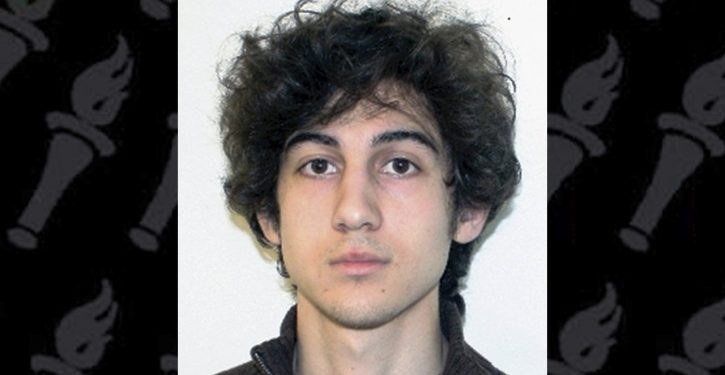
In a 6-to-3 ruling, the Supreme Court has just upheld Marathon bomber Dzhokhar Tsarnaev’s death sentence for his murders and attempt to kill hundreds of people. He and his brother set off two homemade pressure–cooker bombs near the finish line of the Boston Marathon, killing three people, wounding hundreds, and costing 17 people their limbs.
This ruling upholding the death sentence is good news, because the death penalty saves lives by deterring murders. Tsarnaev himself will not be executed until the next Republican presidency, because President Biden has imposed a moratorium on executions for inmates in federal prisons, and that moratorium will not be lifted until the next Republican president, at the earliest.
But most inmates with death sentences are in state prisons where Biden’s moratorium doesn’t apply, and executions can still go forward. The Supreme Court’s ruling rejecting Tsarnaev’s challenge to his sentence lifts a cloud of uncertainty other some other death sentences. If the Supreme Court had ruled in favor of Tsarnaev, it would have effectively ruled that the Federal Death Penalty Act’s evidence provision was unconstitutional, allowing murderers to use unreliable, borderline irrelevant “evidence” to argue against a death sentence, or appeal their death sentence, even if the evidence confuses the jury or could mislead them. That would have endangered state laws and state rules of evidence that likewise bar criminal defendants from introducing such unreliable, marginal evidence in all criminal prosecutions, including cases where the death penalty is sought. State supreme courts also reject such unreliable evidence that has little probative value in challenges by state prison inmates to their death sentences. (See, e.g., People v. Smithy (1999); State v. Davis (2002)).
So if the Supreme Court had ruled in favor of Tsarnaev, some murderers in state prisons would have been able to challenge their death sentences, too.
But the Supreme Court rejected Tsarnaev’s claim that in death penalty cases, a defendant has a constitutional right to introduce evidence of marginal probative value outweighed by other considerations, which the Federal Death Penalty Act says the trial judge may exclude. It said that such unreliable evidence can be excluded to avoid confusing the jury or causing other problems.
It ruled that speculation that a dead co-conspirator of Tsarnaev committed unrelated crimes did not have to be admitted, because that could “confuse the jury” and lacked “probative value.” It noted that the Federal Death Penalty Act already “sets up a highly permissive regime that allows criminal defendants to introduce a wide range of normally inadmissible evidence” at the sentencing phase of the trial. It declined to further expand the sort of evidence a criminal can introduce in a way that would displace “the Federal Government’s ‘traditional authority’ ‘to decide that certain types of evidence may have insufficient probative value to justify their admission.'” “Here, the bare inclusion of the Waltham murders evidence risked producing a confusing mini–trial where the only witnesses who knew the truth were dead,” it said.
In the rare cases where it is carried out, the death penalty saves lives by deterring people from committing murder. Several studies found that it deters killings of innocent people. As the Associated Press noted in 2007, “Each execution deters an average of 18 murders, according to a 2003 nationwide study by professors at Emory University. (Other studies have estimated the deterred murders per execution at three, five, and 14).”
After the death penalty is abolished in a state, death-penalty abolitionists shift to trying to abolish life imprisonment without parole. After Virginia’s Democratic-controlled legislature abolished the death penalty in 2021, the pro-abolition legislators came back the next year and tried to effectively abolish life without parole, too. They proposed the “second look” law, which would have let even mass murderers serving life without parole seek release from prison after 10 or 15 years. The second-look law passed the Democratic-controlled Virginia state senate, but then was killed by the Republican controlled House of Delegates.
Te death penalty is a critical buffer zone around life without parole, helping insulate it from challenge. As long as the death penalty was regularly carried out, death penalty opponents would point to life without parole as a better alternative. But after its frequency waned, some death penalty opponents in the U.S. began attacking life without parole as well.
Similarly, after the death penalty was abolished in Europe, many activists who had once campaigned against the death penalty shifted to attacking life without parole (critics of life without parole call it a “hidden death sentence.”) The result was that courts began to strike down life without parole — such as when a European Court in 2013 overturned Britain’s practice of imposing life without parole on the worst murderers who killed again after being released from prison for a prior murder. The court claimed life without parole is “inhuman and degrading” and thus violated the EU Charter.
As Ed Morrissey notes, “Life without parole developed — at least in the U.S. — as a means to give the state an option to the death penalty.”


